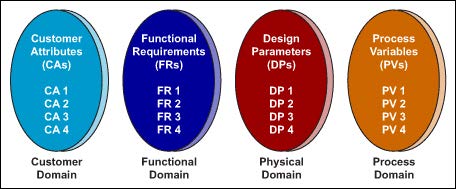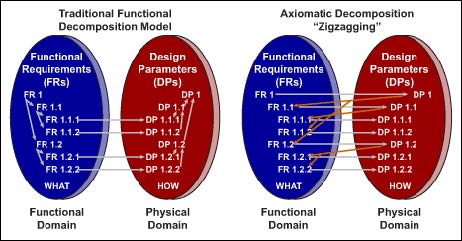Assess Design Alternatives with Axiomatic Design
By Al Hamilton
Even with strong programs, processes and control initiatives, some products still are more robust and better performers than others. With the operational side of their businesses under good process control, companies now find that quality and robustness must be designed into the product. No amount of analysis and parameter tuning can markedly improve a product with fundamental contradictions designed into it.
Axiomatic design provides a rational and scientific way to develop and assess design alternatives, and preemptively addresses and resolves design issues that traditionally are discovered so late that only suboptimal compromises are possible. Axiomatic design focuses on designed-in quality, and is proving to be a friendly framework to integrate with Design for Six Sigma (DFSS), QFD (quality function deployment), TRIZ (Theory of Inventive Problem Solving), and FMEA (failure mode and effects analysis).
Is Design an Art of a Science?
Traditionally design has been treated as an art. Artistic processes are characterized as having a variety of possible outcomes for a given stimulus. There does appear to be a paradox at work here, however. If 10 designers work independently on the same problem, it is generally accepted that they will arrive at 10 different solutions. If these same 10 designers were to share their results, however, they would quickly agree that one or two of the solutions dominated, implying that a large percentage of their design efforts were suboptimal.
This scenario says two important things about the design process today. First, the process of developing a quality design is not repeatable in most organizations. Second, designers know good design results when they see them. The usual design process becomes one of iteration, as design efforts converge on good designs by trial and error. Throughout human history, major gains have been made when activities that were considered crafts were studied and synthesized into scientific principles. The challenge of a design process technology is to develop these guiding principles and a set of rules for applying them, in effect, to develop the science of design.
MIT Professor Nam Suh was driven by this challenge. During his tenure as the director of engineering at the National Science Foundation and later chairman of the Mechanical Engineering Department of MIT, he developed the axiomatic design process that has sparked a renaissance in design. Wrote Suh in his book, Axiomatic Design – Advances and Applications, “This intellectual Renaissance is possible because good design decisions are not as random as they appear to be but are a result of systematic reasoning, the essence of which can be captured and generalized to enhance the design process.”
In his research, Suh observed that good, robust designs shared a small number of common characteristics. Proposing that the essence of “good design” could be captured, Suh set forth a series of design synthesis axioms (statement that cannot be proved true but has never been contradicted) and corollaries.
Axiomatic design is based on two axioms. The first states that elements of a robust design must maintain their functional independence. The second axiom states that a design should have minimal entropy, as measured by what Suh defines as informative content. To get to the point where the axioms can be applied, a design using the axiomatic decomposition process must be developed.
Axiomatic Decomposition
In his book, Suh defines design as “an interplay between what we want to achieve and how we want to achieve it.” Any design process must be able to move from high-level “whats” through to detailed decisions about a multitude of “hows,” a progression known as decomposition. The concept of decomposition is not new, but axiomatic design brings two important concepts to the table: solution neutrality and functional thinking. In doing so, axiomatic design breaks the usual temptation to leap to solutions by inserting specific, interim steps that require the functions of a system to be identified and qualified.
Dr. Mike Shipulski, director of engineering at Hypertherm, a manufacturer of plasma cutting systems, has made extensive use of axiomatic design. Shipulski observes, “By first defining the functions we are to achieve, we align our problem solving on the right areas and broaden possible design opportunities. With axiomatic design, we have a framework for avoiding problems that are often detected only during system level testing.”
Axiomatic design breaks the design process into four domains, shown in Figure 1.

- 1. The customer domain can be thought of as the voice of the customer (VOC).
- 2. The functional domain is initially populated by mapping the VOC into independent measurable functions. High-level functions are driven by the customer; lower-level functions are driven by design choices. Every function must be measurable.
- 3. The physical domain is the domain of physics, chemistry, math and algorithms.
- 4. The process domain is where the specifics of how the design parameters identified in the physical domain will be implemented.
Many organizations make a classic mistake in their functional analysis. They identify the hierarchy of functions, sub-functions and sub-sub-functions before beginning to address how to implement these functions. This traditional decomposition method violates the axiomatic requirement of solution neutrality. It is not possible to do decomposition in a single domain without having a pre-conceived solution in mind. This practice results in both limited options (less creative solutions) and inherent structural flaws.
Suh’s critical insight – that design is the interplay between what you want to achieve and how you achieve it – suggests that there is a better way to understand the relationship between the functions of a system and design elements. Lower-level functions of a system should not be determined a priori but should be driven by the design choices at the next higher level. In short, when making a design choice that satisfies a function, the next question should be, “What are the functions of that design choice?” This process is called zigzagging. Zigzagging preserves solution neutrality and allows systematic examination of multiple solutions.
Figure 2 compares a traditional decomposition process with axiomatic decomposition. The comparison makes two things apparently quickly. First, in the traditional process, the flow is unidirectional. Will a disconnect only be found in testing?

The second difference is the number of linkages between the domains. The traditional process is characterized by having limited communications between the domains, and all the communication is one way, the “throw-it-over-the-wall” approach. Axiomatic decomposition is characterized by a much richer, two-way communication.
Conclusion
Jeff Theilman, a hardware engineer at Hewlett-Packard, observes, “Axiomatic design provides a systematic way to take into account customer wants and proceed in an orderly way to a detailed, specific solution.” Having identified several different design choices, design axioms can be applied to identify the superior choice. Shipulski puts it more succinctly: “Axiomatic design moves design from argument to analysis.”

